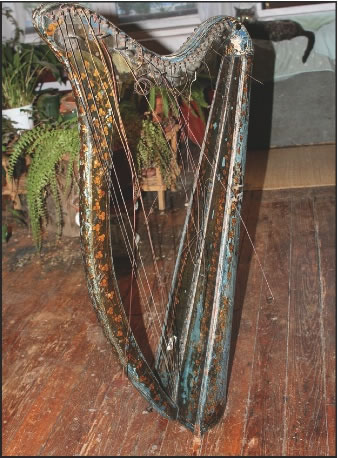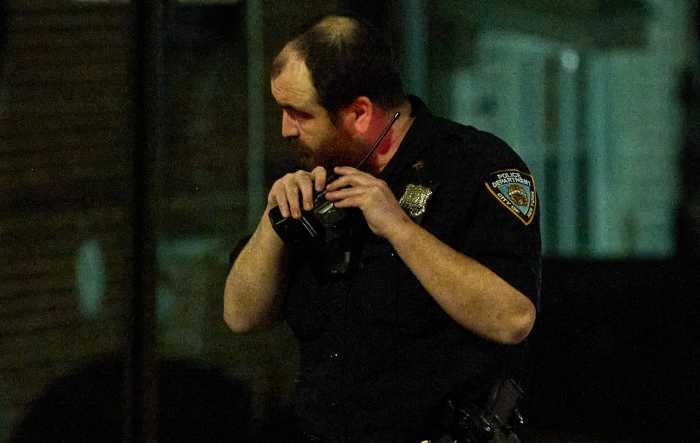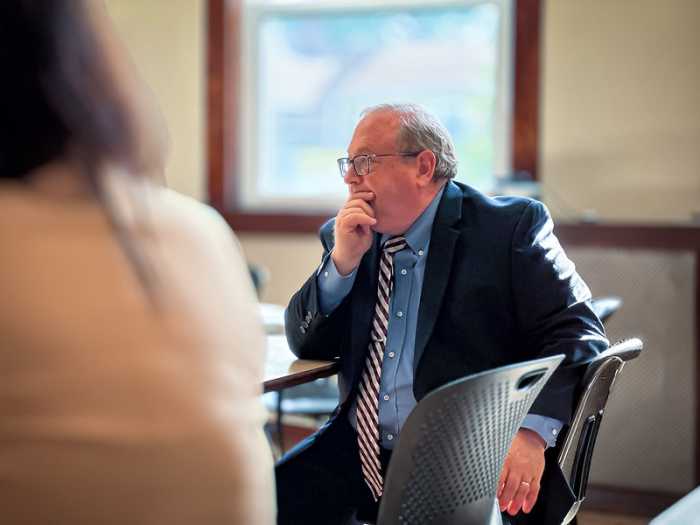By Will Glovinsky
For Lorcan Otway, a local balladeer, archivist and activist, it was the catch of a lifetime.
On July 1, Otway’s friend Julie M. Finch was walking on W. 26th St. when she noticed some furniture in a dumpster. She peered closer to find the venerable curve of a harp piled amid the rubbish. Finch excavated the grimy and blackened instrument, brought it home and sponged it down.
“The sponge was black,” she recalled, “but I thought, ‘What a beautiful shape!’ ”
Within a week she had contacted her friend Otway, an Irish-music enthusiast whom she knows through her Quaker meeting, and he bought the historic instrument for a “small price.”
“If this hadn’t come to me, then I would be sitting in a pub talking about it,” Otway said.
Upon inspection by Finch and Otway, the harp, which will require restoration, proved to be a John Egan original, built in Dublin in the early 19th century. Egan combined the traditional Irish harp shape with greater tonal versatility to produce a model that would foment a resurgence in the harp’s popularity around the time the last bardic Irish harpers — who played harps capable of only a single tuning — were dying out. Egan’s harps, and those like them, have since gained international usage and acclaim.
“Egan essentially created the modern Irish folk harp,” Otway said.
According to Nancy Hurrell, a harp historian currently writing a book on Egan, there are only about 70 Egan harps extant, almost all of which reside in the collections of museums and universities.
This harp, which presently resides in Otway’s living room, appears to be an early example of Egan’s work. Egan received a royal warrant for his harps from King George IV, who reigned from 1820-’30, after which Egan inscribed the monarch’s endorsement on a plate affixed to his harps, or Royal Portables, as the specific model was henceforth known.
Otway’s harp, however, bears no royal mark, so the owner thinks the found harp was built sometime before Egan received that recognition.
Hurrell estimated that the instrument dates from between 1810 and 1820. While noting that a harp from the 18th century would be an “extremely rare find,” she judiciously classified Otway’s harp as “rare.”
“I’ve only known of three Egan harps from that period,” she said.
Since the harp came into his possession, Otway has been investigating the curious instrument. In particular, he is intrigued by the presence of parts from two different kinds of key-shifting mechanisms. This incongruity is only one of the many questions he has.
“There are many little mysteries,” said Otway. “It’s one of those things where the story gets bigger as it goes on.”
Indeed, the harp’s recent history is equally colorful. Through Finch, who originally found the harp, Otway learned that the instrument had been in the estate of Rose Augustine, who along with her husband, Arthur, invented the first successful nylon guitar string. It so happened that the Augustines were friends and neighbors of classical guitar virtuoso Andres Segovia, who eventually championed the use of their nylon strings.
Rose Augustine, who died in 2003, collected rare musical instruments, one of which was the harp in question. How exactly the Egan harp ended up in a dumpster remains a mystery, although Otway surmises that the executor of Augustine’s will tried to sell the harp but was unsuccessful and finally discarded it.
Otway hopes that the next stage of the harp’s life will return it to the world of musicians and recitals. He foresees a semiannual concert series with “gifted musicians from appropriate traditions,” with proceeds going to both pressing world hunger crises and to benefit elderly members of his Friends meeting.
For now, though, he seeks a master restorer who will balance the instrument’s musical potential with its historical importance. The project will be no mean feat. Hurrell, the harp expert, explained that unless the original sound box is replaced, it will probably be delicate and even liable to “explode” if not properly handled. However, a new sound box would decrease the overall authenticity of the instrument.
At any rate, the restoration of the harp, whose historical and sentimental value far outstrips any monetary value it may have, will certainly be costly and lengthy.
“I may have to sell a set of my uilleann pipes,” said Otway, referring to the signature Irish reed instrument. But he said he wouldn’t mind the sacrifice. “I’m just honored to accompany this harp into its third century.”






































